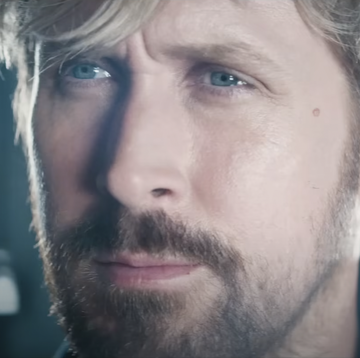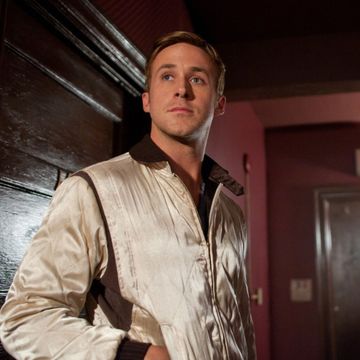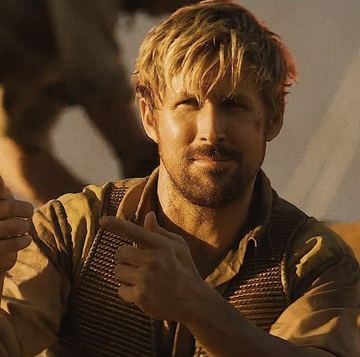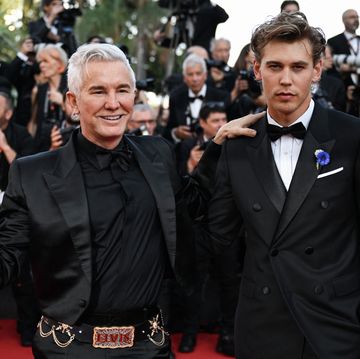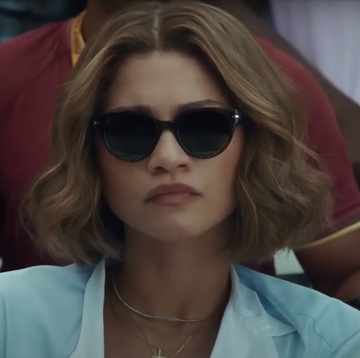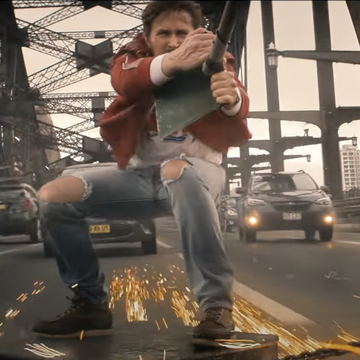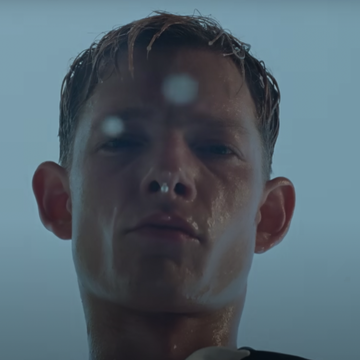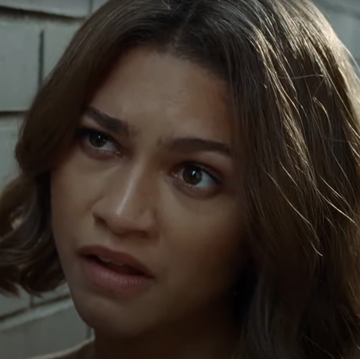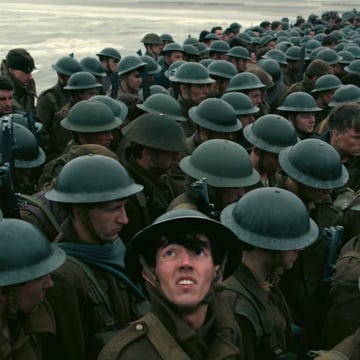The last ten years of summer movie seasons have been filled with great excuses to hide from 100-percent humidity, but only a few certifiably fantastic movie-going experiences. Steven Spielberg's War of the Worlds was up there. 2008's one-two punch of Iron Man and The Dark Knight. The last two Bourne movies finally gave adults something to chew on. The Avengers was an event that only its sequel could rival. Anything else?
This week, we finally get a movie that, as time goes by, could settle into classic territory. George Miller's Mad Max: Fury Road is a strap-you-in, drop-your-jaw, blow-you-back kind of epic. The movie starts small and escalates, Charlize Theron and Tom Hardy's nuts-and-bolts performances ensuring that the scrapyard juggernaut keeps itself together. It's the rare Hollywood picture that could use the "0 to 60" idiom and get away with it, but way too modest to call itself "fast" or "furious"—Mad Max just is.
Why? Because Mad Max: Fury Road…
…forgets the introductions.
If you've seen director's George Miller's first three Mad Max movies—the eponymous original, the sequel, Road Warrior, among the greatest action movies of all time, and Beyond Thunderdome, the twisted version of Hook you didn't know you needed—then you'll catch the few scant callbacks woven into Fury Road. But no fear, out-of-the-loop friend: the references come and go like a mile marker. Same goes for back story—the fourth Mad Max is expositionally introverted. A desert kingdom ruled by the wheezing tyrant Immortan Joe exists because someone was going to take the reins on a decimated society. Indulgences turn him evil. A lethal rebel named Furiosa (Charlize Theron) kicks off a movie-long chase by breaking Immorten Joe's five "wives" (played by Rosie Huntington-Whiteley, Courtney Eaton, Zoe Kravitz, Abbey Lee, and Riley Keough). out of captivity. Her reasoning is simple: no woman deserves to live that way. So she busts them out. "Mad" Max Rockatansky (Tom Hardy), the reluctant hero who joins her quest, begins as Joe's captive too. He's a walking blood bag, periodically drained to keep the leader's mutant soldiers alive. An hour plugged into their universal donor hostage and the "War Boys" are ready to go. Miller spares us the tedium of a throwaway character explaining all this. We see it. We soak it up. And then the engines rev up.
…runs amok in a world built from the ground up.
Miller constructs his imaginative dystopia with the kinetic energy of action filmmaking. Each shot brims with cultural details that evolved over 100 years of worst-case-scenario behavior. Immortan Joe and the War Boys pray at the alter of a steering wheel deity; the Wasteland carves its class system out of the nooks and crannies of its igneous intrusion, soot and war paint adding to the heated race relations; and in this future, heavy women spend their days hooked up to milking machines, a nectar for the privileged. It's all shocking and thoughtful, diverse and cogent, fuel for the fire. Fury Road's wackiness is reasoned. Before the war boys attack Furiosa's tanker, they spray metallic paint across their mouths, a final ritual before entering Motor City Valhalla. The ritual is an extra shot of bizarre that adds to the overall danger. Buying in to blood-guzzling, carburetor-worshiping jihadists shouldn't be this easy. That's Fury Road's hook. Miller builds suspense out of the pervasive notion that anything is possible in this strange, extrapolated universe.
…scraps the whole "world domination" plot.
Everybody wants to rule the world… except Immorten Joe, who simply wants his playthings back. With every evil-doer aiming to wipe out humanity and proclaim Earth for his or hear own, Fury Road whittles down villainy to its most carnal, and disturbing, motivations. Joe, like men before him, go to war over chauvinistic pride. Actor Hugh Keays-Byrne (who, fun fact, appeared in the 1979 Mad Max) plays the character at maximum sliminess. His corruption as a man of power, and the manipulation tactics he employs to stay in that position, make him pure evil. He is Jabba the Hutt meets Darth Vader. You can't wait to see Furiosa sock him in his breathing tube.
…applies its brain to the those 'splosions.
You knew Disney World's Catastrophe Canyon tour was no bullshit because every explosion sent the smell of gasoline and burnt rubber wafting through the air. The tour confirmed what we saw on screen: practical effects scorched the senses. Computer graphics widened the scope of spectacle films while sacrificing odors, tastes, and skin-tingling aftershocks—leveling a city can be surprisingly vanilla. Fury Road is a corrective, a tribute to practical effects that scorch the hair off onlookers (or at least feel like they do). The film hides any CG trickery under vehicular shrapnel, erupting engines, and plumes of black smoke, achieved by actually smashing cars into one another. Even the scenery carries weight; in a sequence where Max, Furiosa, and the wives flee through a canyon pass, an avalanche of boulders barrels down a cliff with dusty chaos. If it's faked with CG, it's immaculate. Like it's storytelling, Fury Road is obsessed with the question: "how does the world work?"
…rolls around in the grime
Fury Road is dirty. If our heroes aren't drenched in oil, ash, and "guzzolene," they're covered in kicked up sand. It's Miller shot Fury Road in the barren Namib desert and it keeps everything—cars, sets, actors—covered in a thin coat of post-apocalyptic waste. Treads can barely rip through the thick sand—and they occasionally fail. Max and Furiosa yanking their 18-wheeler out of a muddy patch looks about as easy as pulling a jet with one's teeth. In Fury Road, the terrain is as brutal as the weapons.There's not a soundstage in sight.
…propels forward, with or without you.
The average blockbuster starts and stops like a clunky Oldsmobile. Plot, plot, action, plot, plot, plot, action, action, plot, fin. This is the blueprint for Marvel's perpetual motion machine—there's always a someone and a something to chase to the next picture. Fury Road has a MacGuffin—five gorgeous, tough-as-nails ones, to be exact—but Miller refuses to detour the action to yak about the rising stakes or major twists (of which there many). The film's machinations occur in real time, amidst incoming waves of spear-wielding bikers or a moving pitstop (there's always someone on Max and Furiosa's heels) to fix broken gas valves. Fury Road is story-driven; It's not just that one of the wives is pregnant or that Nicholas Hoult's ghastly War Boy is losing his faith. Fury Road is about how characters remain characters while outdriving murderous roadsters at 80 miles per hour.
…tells everyone to shut up and drive.
Action, even the fighting-mutants-on-a-monster-truck's-front-hood kind, speaks louder than words. Without too much plot to hash out, Miller is able to keep dialogue to a minimum. If that sounds arty, remember that 1. You sat through The Artist and 2. Your brain loves its pictures. Miller is a maestro because he subconsciously informs our brain. An insert shot tells us there's a weapon stashed in a hidden compartment. Scars on one girls' arms provide the character history we thought we needed. And he employs actors who don't need words to say everything about a situation. Hardy and Theron have the most piercing eyes in the business. They grunt, they cry, they shout, they barely say a thing. Words wouldn't be that handy, honestly. Plowing through the Fury Road is too damn loud.
…turns every frame into a work of art.
Miller takes a painter's approach to realizing Fury Road's apocalyptic visions. Reds, yellows, and sky blues mix and layer with consistent beauty. The film's trailer played up an electrifying sandstorm that, on the big screen, is up there with John Martin's The Great Day of His Wrath. When Hell isn't swirling, the film's still a sight to behold. For a few scenes, a night-draped desert subdues Fury Road's grungy backdrop. And then Immortan Joe's squadron tears it in two with razor-edged war machines. If Francisco Goya painted Heavy Metal magazine, it'd look something like Fury Road, a far cry from its squarely-lit competition.
…booms like thunder because that's war.
Movies are louder than ever, thanks in no small part to the Inception BRAAAAM effect. Fury Road will still make your rib cage warble with bass, but Miller builds the reasoning into the movie. Immortan Joe brings a car full of timpani drummers and a guy whose electric guitar spits fire for the same reason the Continental Army recruited fife and bugle players for the Revolutionary War. This is a troop preparing to kill. They need to be amped. Fury Road's score is propulsive and bursting at the seams like many a summer movie. The difference: it blasts from within.
…is about something.
Theme in action movies often feels like an accident. Having a robot villain is not the same as spinning a cautionary tale of man and artificial intelligence (even if it looks cool). Fury Road, in contrast, is stuffed with legitimate, provocative allegory, contrasting who we are now against who we'll become. Immortan Joe and the Wasteland are a devolved civilization, the worst of man. They've turned to a religion that mirrors faiths of the East and West. Joe's ownership over women warps the minds of his captives—they don't know whether to run or remain safely compliant. Huntington-Whiteley's told Esquire that she worked with playwright Eve Ensler to explore themes of victimhood. It's all there on screen, not only an alternative to Hollywood's damsels-to-distress, but circling around to treat female characters people. They can thrive, they can suffer, then can be Charlize ass-kicking Theron harboring a tormented past and an unknown future. There's a welcome lack of romance between her Furiosa and Hardy's Max. They come together to accomplish a goal. They do so with tremendous power.
Mad Max: Fury Road: So good, we're scared to wish for a sequel.


